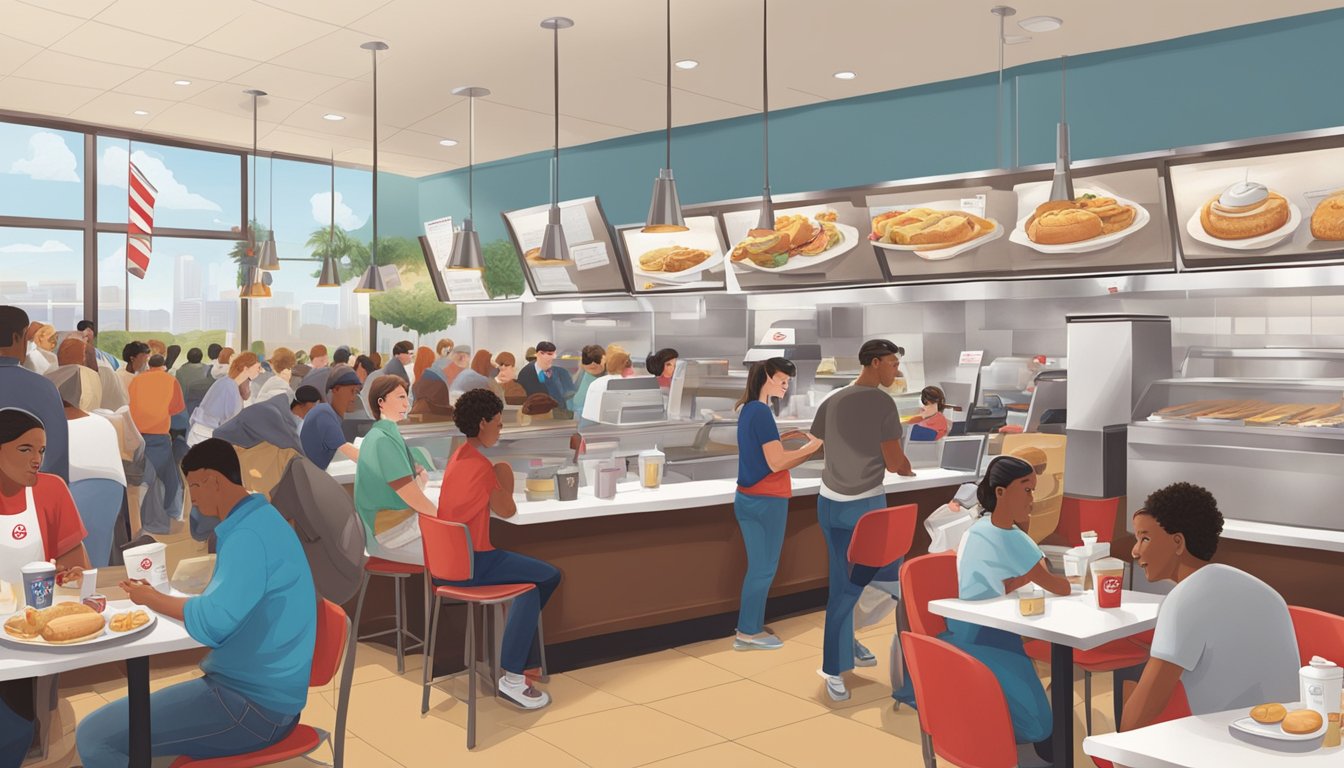Chick-fil-A’s breakfast menu has become a formidable force in the fast-food industry. The chicken-centric chain’s morning offerings have not only attracted loyal customers but also influenced competitors to step up their breakfast game. Chick-fil-A’s success in the breakfast market has prompted other fast-food chains to expand and innovate their morning menus, leading to increased competition and variety for consumers.
The company’s focus on quality ingredients and signature chicken-based items sets it apart from traditional breakfast fare. Chicken biscuits, egg sandwiches, and breakfast burritos featuring chicken as a primary ingredient have become staples of Chick-fil-A’s morning menu. This unique approach has resonated with customers, driving other chains to rethink their breakfast strategies.
As Chick-fil-A continues to dominate the breakfast space, competitors are forced to adapt or risk falling behind. The chain’s influence extends beyond menu items, impacting pricing strategies and customer service standards across the industry. This shift in the fast-food breakfast landscape demonstrates the significant impact Chick-fil-A has had on shaping consumer expectations and competitor offerings.
Overview of Chick-fil-A
Chick-fil-A stands as a prominent fast-food chain known for its chicken sandwiches, distinctive brand identity, and customer-focused approach. The company’s unique business model and commitment to values have propelled it to significant success in the restaurant industry.
Founding and History
Truett Cathy founded Chick-fil-A in Atlanta, Georgia in 1946. The restaurant began as the Dwarf Grill, later renamed Dwarf House. Cathy’s original chicken sandwich recipe became the foundation for Chick-fil-A’s menu.
In 1967, Cathy opened the first Chick-fil-A restaurant in Atlanta’s Greenbriar Shopping Center. The company’s name is a play on “chicken fillet,” reflecting its signature product.
Chick-fil-A expanded steadily over the decades, maintaining a focus on quality food and customer service. By 2023, the chain had grown to over 2,600 locations across the United States.
Brand Values and Mission Statement
Chick-fil-A’s mission statement emphasizes “glorifying God by being a faithful steward of all that is entrusted to us.” This ethos influences the company’s operations and culture.
Key brand values include:
- Providing quality food and exceptional service
- Treating employees and customers with honor and respect
- Giving back to local communities
The company’s policy of closing on Sundays reflects its commitment to these values, allowing employees time for rest and worship.
Chick-fil-A’s brand recognition is bolstered by its cow mascots and “Eat Mor Chikin” marketing campaign, which has become iconic in the fast-food industry.
Franchise Model and Operational Excellence
Chick-fil-A employs a unique franchise model that sets it apart from competitors. The company charges a low initial franchise fee of $10,000, significantly less than many other fast-food chains.
Franchisees are carefully selected based on their alignment with Chick-fil-A’s values and goals. The company maintains significant control over franchise operations, ensuring consistency across locations.
This model has contributed to Chick-fil-A’s operational excellence. The chain is known for:
- Efficient drive-thru service
- Cleanliness of restaurants
- Friendly and attentive staff
In 2023, Chick-fil-A generated $21.58 billion in sales, a 14.7% increase from the previous year, demonstrating the effectiveness of its business approach.
Chick-fil-A’s Breakfast Menu
Chick-fil-A’s breakfast offerings combine classic favorites with innovative creations, all centered around their signature chicken. The menu features high-quality ingredients and unique items that set it apart from competitors.
Introduction to Breakfast Offerings
Chick-fil-A launched its breakfast menu in 1986 with the simple Chicken Biscuit. Since then, the menu has expanded to include a variety of options catering to different tastes and preferences. Customers can choose from hearty sandwiches, lighter fare, and sweet treats.
The breakfast menu is available during morning hours, typically until 10:30 AM. It offers a balance of protein-rich meals and lighter options, ensuring there’s something for everyone.
Signature Breakfast Items
Chick-fil-A’s breakfast menu boasts several standout items:
- Chicken Biscuit: A hand-breaded chicken fillet on a freshly-baked buttermilk biscuit
- Chick-n-Minis: Bite-sized chicken nuggets nestled in warm, mini yeast rolls brushed with honey butter spread
- Egg White Grill: Grilled chicken, egg whites, and cheese on a multigrain English muffin
- Breakfast Burrito: Scrambled eggs, chicken, and cheese wrapped in a soft tortilla
These signature items showcase Chick-fil-A’s focus on chicken-centric breakfast options. The menu also includes hash browns, Greek yogurt parfait, and fruit cups as sides or lighter alternatives.
Ingredient Quality and Menu Innovation
Chick-fil-A prioritizes ingredient quality in its breakfast offerings. The chicken is hand-breaded and pressure-cooked in 100% refined peanut oil. Eggs are freshly cracked, and biscuits are baked throughout the morning.
The chain continues to innovate its breakfast menu. Recent additions include:
- Hash Brown Scramble Bowl: A protein-packed option with chicken, scrambled eggs, and hash browns
- Bacon, Egg & Cheese Muffin: A classic breakfast sandwich on an English muffin
Chick-fil-A’s commitment to quality ingredients and menu innovation helps maintain its competitive edge in the breakfast market. The unique offerings, like Chick-n-Minis, set it apart from other fast-food chains and attract loyal customers.
The Fast-Food Breakfast Landscape
The fast-food breakfast market is fiercely competitive, with major chains vying for customers’ morning appetites. Key players have developed unique menu offerings and strategies to capture market share in this lucrative segment.
Key Competitors’ Breakfast Menus
McDonald’s leads the breakfast wars with its iconic Egg McMuffin and extensive menu options. Their all-day breakfast initiative revolutionized the industry.
Burger King counters with croissant sandwiches and French toast sticks, appealing to those seeking variety.
Wendy’s entered the breakfast arena more recently, focusing on fresh-cracked eggs and signature items like the Breakfast Baconator.
Subway offers breakfast sandwiches on their signature bread, catering to health-conscious consumers.
KFC and Popeyes leverage their chicken expertise, incorporating it into morning offerings like chicken biscuits.
SWOT Analysis of Competitor Brands
Strengths: Established brand recognition, extensive distribution networks, and loyal customer bases.
Weaknesses: Inconsistent quality across franchises, health perception issues for some menu items.
Opportunities: Growing demand for convenient breakfast options, potential for menu innovation and healthier choices.
Threats: Increasing competition from fast-casual restaurants, changing consumer preferences towards healthier options.
McDonald’s strength lies in its breakfast menu variety, while Burger King struggles with brand perception in the breakfast category.
Breakfast Wars: Menu Differentiation
Fast-food chains employ various strategies to stand out in the crowded breakfast market. McDonald’s focuses on classic items and value pricing.
Wendy’s emphasizes freshness with made-to-order meals. Subway differentiates itself with customizable options and a perceived healthier image.
KFC and Popeyes leverage their chicken expertise to create unique breakfast offerings. Burger King aims to attract customers with bold flavors and indulgent options.
Menu innovation remains crucial, with chains regularly introducing limited-time offers to generate buzz and attract new customers.
Consumer Behavior and Preferences

Chick-fil-A’s breakfast offerings have significantly influenced consumer behavior and preferences in the fast-food industry. Customers increasingly prioritize quality, convenience, and value when making breakfast choices.
Demand for Healthier Alternatives
Health-conscious consumers seek nutritious breakfast options. Chick-fil-A has responded by introducing items like Greek yogurt parfaits and egg white grill sandwiches. These choices appeal to those watching their calorie intake or looking for protein-rich meals.
Many customers now expect fast-food chains to offer fresh ingredients and balanced menu items. This shift has prompted competitors to expand their healthy breakfast selections. Transparency in nutritional information has become crucial for informed decision-making.
Chick-fil-A’s use of antibiotic-free chicken has set a new standard. Consumers increasingly value restaurants that prioritize quality ingredients and ethical sourcing practices.
Impact of Dining Experience on Customer Loyalty
Chick-fil-A’s renowned customer service has raised the bar for breakfast experiences. Friendly staff, efficient drive-thru operations, and clean dining areas contribute to customer satisfaction.
Personalized interactions and attention to detail foster emotional connections. These positive experiences encourage repeat visits and brand loyalty.
Mobile ordering and loyalty programs have enhanced convenience. Customers appreciate the ability to customize orders, skip lines, and earn rewards.
The restaurant’s consistent quality across locations builds trust. This reliability is a key factor in maintaining a loyal customer base.
Price Sensitivity and Value Perception
Breakfast consumers are often price-sensitive due to the frequency of purchases. Chick-fil-A balances quality and affordability to provide perceived value.
Combo meals and promotional offers appeal to budget-conscious customers. These deals create a sense of getting more for their money.
The perceived quality of ingredients justifies slightly higher prices compared to some competitors. Customers are willing to pay more for food they believe is superior.
Value extends beyond price to include portion sizes, taste, and overall satisfaction. Chick-fil-A’s ability to deliver on these factors influences customer perceptions of value.
Seasonal menu items and limited-time offers create excitement and drive sales. These strategies tap into consumers’ desire for novelty while maintaining core favorites.
Chick-fil-A’s Market Influence
Chick-fil-A has established itself as a major player in the fast food industry, shaping consumer preferences and driving innovation among competitors. The company’s unique approach to customer service, menu offerings, and marketing strategies has propelled it to significant market success.
Adapting to Consumer Tastes
Chick-fil-A’s menu diversity has been a key factor in its market influence. The chain offers breakfast, lunch, and dinner options, catering to various customer preferences throughout the day. Its breakfast menu, in particular, has forced competitors to expand their morning offerings.
Chick-fil-A’s focus on quality ingredients and healthier options has also set new standards in the industry. The company’s use of antibiotic-free chicken and fresh produce has pushed other fast food chains to improve their ingredient sourcing and menu quality.
By consistently introducing innovative items like the Egg White Grill sandwich, Chick-fil-A has kept its menu fresh and appealing to health-conscious consumers. This approach has helped maintain customer interest and drive repeat visits.
Promotions and Customer Engagement
Chick-fil-A’s promotional strategies have significantly impacted its market position. The company’s “Eat Mor Chikin” campaign, featuring cows encouraging consumers to eat chicken, has become an iconic and highly effective marketing tool.
The chain’s loyalty program, Chick-fil-A One, has set a new standard for customer engagement in the fast food industry. By offering personalized rewards and easy mobile ordering, the program has boosted customer retention and increased visit frequency.
Chick-fil-A’s community involvement, including local sponsorships and charitable initiatives, has strengthened its brand image. This approach has fostered strong customer loyalty and positive word-of-mouth marketing.
Revenue and Profitability Growth
Chick-fil-A’s market influence is clearly reflected in its financial performance. The company has experienced remarkable growth in both market share and revenue over recent years.
Despite being closed on Sundays, Chick-fil-A’s per-unit sales often surpass those of competitors who operate seven days a week. This efficiency demonstrates the strength of Chick-fil-A’s business model and customer appeal.
The chain’s focus on operational excellence and customer service has contributed to high profitability. By maintaining a lean menu and emphasizing quality over quantity, Chick-fil-A has managed to keep costs under control while driving sales growth.
Challenges and Controversies

Chick-fil-A’s breakfast menu innovations have not been without obstacles. The company faces several key issues as it strives to maintain its competitive edge in the morning meal market.
Dealing With Backlash
Chick-fil-A has encountered public criticism due to its political stances. Some customers have boycotted the chain over its past donations to organizations perceived as anti-LGBTQ+. This controversy has affected breakfast sales in certain markets.
The company has attempted to distance itself from these issues by focusing on its food quality and customer service. However, lingering negative perceptions continue to impact its brand image in some regions.
Chick-fil-A has increased its charitable giving to a wider range of organizations. This strategy aims to rebuild trust and broaden its appeal to diverse customer groups during breakfast hours.
Overcoming Market Saturation
As Chick-fil-A expands its breakfast offerings, it faces intense competition in an already crowded market. Many fast-food chains have strengthened their morning menus, making it challenging to stand out.
The company has responded by emphasizing its unique chicken-based breakfast items. It has also invested in marketing campaigns to highlight the freshness and quality of its morning meals.
Chick-fil-A’s limited operating hours, including Sunday closures, may hinder its ability to capture market share. Competitors with longer hours often have an advantage in serving early-morning customers.
Menu Limitations and Pricing Strategy
Chick-fil-A’s breakfast menu, while popular, lacks the diversity of some competitors. The focus on chicken-based items may not appeal to all customers seeking variety in their morning meals.
The chain’s commitment to high-quality ingredients results in higher prices compared to some competitors. This pricing strategy may deter budget-conscious breakfast consumers.
To address these challenges, Chick-fil-A has introduced limited-time offerings and seasonal items. These additions aim to provide more options without compromising the core menu.
The company has also implemented targeted promotions and combo deals to offer better value. These efforts help offset concerns about higher prices while maintaining profit margins.
Future of Quick-Service Restaurants

Quick-service restaurants are evolving rapidly to meet changing consumer demands. Technological advancements, shifting preferences, and global opportunities are reshaping the industry landscape.
The Shift Towards Fast Casual
Fast casual concepts are gaining traction in the QSR space. These restaurants offer higher quality ingredients and customizable options at slightly higher price points than traditional fast food.
Many QSRs are adopting fast casual elements to stay competitive. Enhanced interior designs, open kitchens, and made-to-order preparation are becoming more common.
Menu innovation is a key focus. QSRs are introducing premium ingredients, healthier options, and unique flavor profiles to appeal to discerning customers.
Role of Technology and Service Innovation
Technology is transforming how QSRs operate and interact with customers. Mobile ordering and payment apps are now standard, improving convenience and reducing wait times.
Self-service kiosks are increasingly prevalent, allowing customers to customize orders and reducing labor costs for restaurants.
AI-powered chatbots and voice ordering systems are emerging, enhancing customer service and streamlining operations.
Delivery partnerships and ghost kitchens are expanding QSRs’ reach beyond traditional brick-and-mortar locations.
Exploring International Expansion
Many QSRs are looking to international markets for growth opportunities. Adapting menus to local tastes while maintaining brand identity is crucial for success.
Asia, particularly China and India, represents a major focus for expansion due to growing middle classes and increasing urbanization.
QSRs are also targeting emerging markets in Africa and Latin America, tailoring their offerings to local preferences and economic conditions.
International expansion requires careful consideration of supply chains, regulatory environments, and cultural nuances in each new market.




